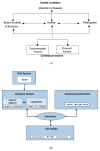Contemporary Speech and Oral Language Care for Deaf and Hard-of-Hearing Children Using Hearing Devices
- PMID: 32019213
- PMCID: PMC7073554
- DOI: 10.3390/jcm9020378
Contemporary Speech and Oral Language Care for Deaf and Hard-of-Hearing Children Using Hearing Devices
Abstract
Contemporary speech and language interventions are not limited to disabilities but embrace the pragmatics of communication behaviors from the perspective of functional social participation. Accordingly, current speech and language therapies for deaf and hard-of-hearing children include a broad spectrum of approaches and techniques. This paper explores contemporary approaches and techniques for speech and oral language interventions for deaf and hard-of-hearing children using hearing devices, evidence of efficacy and how they are implemented in diverse clinical practices.
Keywords: care; child; deaf and hard of hearing; language; speech.
Conflict of interest statement
The authors declare no conflict of interest.
Figures




References
-
- Jalilevand N., Ebrahimipour M., Zarandi M.M., Kamali M., Fayazi L. Comparison of Verbal and Non-Verbal Communication Between Deaf Children with no Cochlear Implantation and Deaf Children 12–24 Months After Cochlear Implantation. Func. Disabil. J. 2018;1:1–7. doi: 10.30699/fdisj.1.3.1. - DOI
-
- Hadjikakou K., Petridou L., Stylianou C. The academic and social inclusion of oral deaf and hard-of-hearing children in Cyprus secondary general education: investigating the perspectives of the stakeholders. Eur. J. Special Needs Educ. 2008;23:17–29. doi: 10.1080/08856250701791211. - DOI
LinkOut - more resources
Full Text Sources

